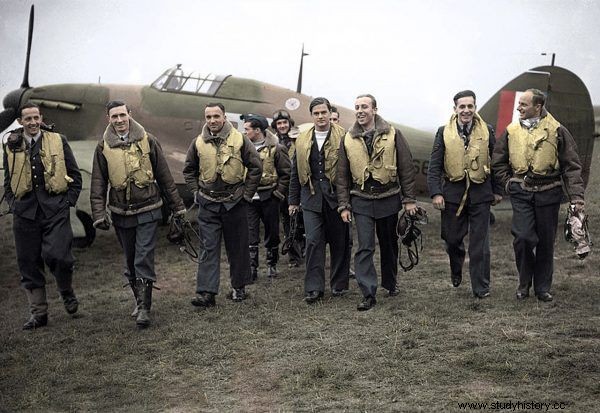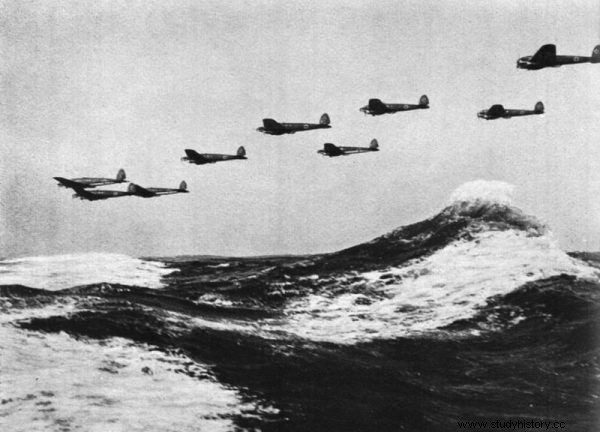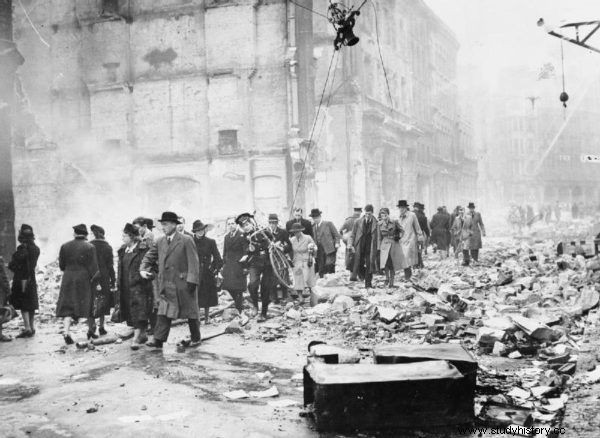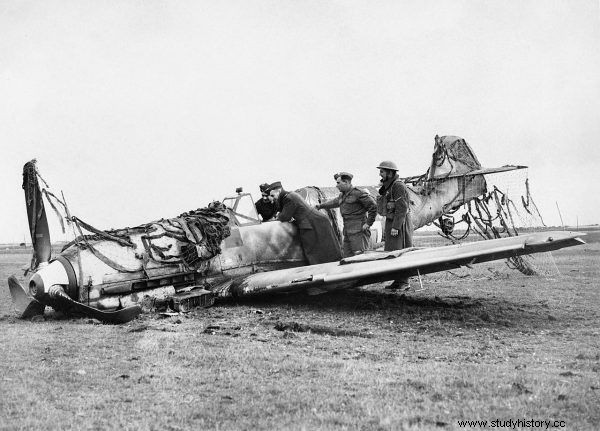It was one of those battles that decided the fate of the world. Hitler seemed to have victory almost in his pocket, and was only a step away from ruling the British Isles. Fortunately, we managed to fight him off. And the Poles contributed greatly to this.
In June 1940, almost all of Western Europe was under German occupation. Great Britain was separated from the German tanks only by the English Channel.
To make matters worse, the British Army has left almost all of its heavy equipment on the beaches of Dunkirk. At the time, it seemed as if it was enough to carry out a sea landing for the last Allied free country to be conquered. The Germans only had to neutralize the British fleet, and before that - to gain an air advantage.
The British found themselves in a really difficult situation. In the fights so far, their air force has suffered large losses in equipment and - more importantly - in trained airmen. And although the industry could have produced a sufficient number of machines, including the most needed fighters at the moment, the staff was lacking.
Polish branches in the UK
Training new pilots took too long. The ranks were replenished first with the reserves of the Royal Air Force (RAF), and then from other countries of the empire - Canada, Australia, New Zealand, South Africa, and volunteers from the United States. In the end, foreign pilots found refuge in the Islands were used. They were Czechs, Slovaks, French, Norwegians, Belgians, Dutch and - the most numerous of all foreigners - Poles.
This summer on the "Island of Last Hope" there were about 1,200 officers and 5,000 non-commissioned officers and privates from the Polish Air Force. Some came to Great Britain in the spring, and the rest after the fall of France. Initially, the British planned to create only Polish bomber squadrons, but the needs prevailed. In July 1940, the formation of two fighter squadrons began:302 (Poznański) and 303 (Warsaw).

In the summer of 1940, around 1,200 officers and as many as 5,000 non-commissioned officers and Polish Air Force rankings. was waiting to take a rematch on the Luftwaffe.
Both units received Hawker Hurricane Mk. I. Although these planes were a bit worse than the German Messerschmitt Bf-109 E, they became a lethal weapon in the hands of Polish pilots. "If such machines were in Poland, how beautiful and how different would it all be" Even one of the Vistula pilots sighed.
The airmen of the fighter units wore British uniforms with "Poland" patches and the Polish eagle on their caps. There could be little red and white checkerboards on the fuselages of their planes. The troops also had a double Polish-British command, although of course the officers from the Islands had more say.
Defense at all costs
When the Polish squadrons were forming, the air battle for the future of the Free World was already in full swing. On the mainland side of the English Channel, the invasion forces were gathering all floating equipment and waiting for an order. The air conquest was carried out by three German air fleets, totaling over 2,600 aircraft, mainly bombers and fighters.
The British initially had 750 fighter machines. In the course of the struggle, this number increased. We must also admit to the islanders that they prepared the battlefield very well. The attacked area was divided into 4 sectors, and the airmen in the air were supported by ground forces - 80 radar stations. They could detect enemy planes from a distance of several hundred kilometers! In addition, there was a network of over a thousand posts where ground observers determined the directions, strength and height of the incoming people.
In addition, the defenders had at their disposal barrier balloons and anti-aircraft artillery batteries. Finally, radio monitoring was very useful. Especially that thanks to the breaking of the Enigma codes by Polish cryptologists and the transfer of their research results and a duplicate coding machine to their allies, the British could read German orders.
The Battle of Britain can be divided into several phases. The first covers the period from July 10 to August 7. At that time, the Germans tried, first of all, to paralyze shipping on the Canal. They sank British ships sailing there and dragged airmen in the area into combat. They attacked the cities at night. When the second stage of the attack began, which lasted until August 23, the attacks on shipping were further intensified. Targeting of southern England airports and radar stations has also begun.

Over 2,600 Luftwaffe machines were supposed to help in bringing Great Britain to its knees. The photo shows Heinkel He 111 bombers over the English Channel.
The most difficult test for the RAF was the third part of the struggle, which ended on September 6. During the day, the Germans attacked airports and radar stations, and at night - cities and aviation factories. The following weeks, after entering the fourth phase, which stretches to September 30, gave fighter aviation a breath as the attacks focused on London.
The last, fifth stage of the battle, i.e. the fight in October, are attacks on cities, fortunately carried out with less intensity. The following months of air combat are called Blitz with the German. The night bombings of cities and the daytime attacks of fighter jets continued until May 10, 1941.
How were the Poles doing?
The first Polish air victory in the Battle of Britain took place on Friday, July 19, 1940. Lieutenant Antoni Ostowicz of the 145th Squadron RAF then shot down a Heinkel He-111 bomber. Other pilots from the Vistula were also successful. They were all characterized by great will to fight, courage and great determination.
Polish squadrons began their military career at the end of August. Poznański entered the fight on August 20; Warszawski ten days later. And while 302 airmen serving in the North of England rarely met German planes, members of the 303 could really prove themselves.

Damage caused by the German air raid on London.
The Warsaw squadron found itself in the midst of the fighting around London and turned out to be extremely valuable in critical moments. It was commanded first by Major Zdzisław Krasnodębski, and then by Lieutenant Witold Urbanowicz. Its pilots set off several times a day to meet the enemy.
During the battle, 303 Squadron defended the heart of the empire, attacked German bombing expeditions and smashed Luftwaffe bombers. Time and time again he forced the crews to drop their cargo in front of the city and to flee in panic. He also fought with a fighter escort, and above all - liquidated German machines in impressive numbers. His achievements quickly surpassed the achievements of British squadrons. According to the reports approved during the war on September 5 alone, the airmen knocked down eight planes from 303. Two days later, they dropped fourteen of them, and on September 11 and 15 - sixteen. And the streak of success did not end there, because on September 26 thirteen victories were reported, and on September 27 - fourteen ...
So much it's suspicious
In total, during the Battle of Britain, 303 Squadron shot down 126 enemy aircraft, which was an absolute record among Allied and German squadrons. Although this result is currently questioned by some historians as overestimated, it is worth remembering that the Polish shootings were verified particularly carefully.
Initially, the successes of the Squadron aroused suspicions of the British. The intelligence officers at the Northolt airport did not believe in the Poles' reports about the number of machines knocked down. Even if British officers flying with Poles have sworn the reports are true!

303 Squadron pilots during Marian C. Cooper's visit (in a suit). who commanded the 7th squadron in the Polish-Bolshevik war. To the right of Cooper Witold Urbanowicz.
Eventually, the British commander of the base flew on one of the missions with 303 Squadron. He saw with his own eyes how the Poles crashed the bombing expedition. “Suddenly the air filled with flaming planes, parachutes and broken pieces of wings. It was so sudden it was deafening, "he wrote in the report, and British reservations vanished.
Soon, Polish knights of the skies defending Albion against the Huns together with the British became celebrities. After all, ordinary inhabitants who watched them from the ground were the witnesses of their fights. Air fights were also reported live by BBC radio. Successes, Polish charm and exotic aura - they came from a country somewhere on the edge of civilized Europe - made Poles the idols of the British, especially British women.
The airmen from 302 Squadron, who were located a bit further from the main battle front, gained less fame. On September 15, they were assigned to fight over London as the RAF's last reserve. They shot down 11 Luftwaffe planes then for sure and 7 probably. Three days later it was similar - they passed 9 machines for sure and 3 probably. On October 11, 302 Squadron was moved near the British capital to the place of the 303 Squadron sent to rest, but ... the Germans changed their tactics and stopped mass daily raids.
In total, the Squadron liquidated 27 German planes for sure and 11 probably. On the other hand, the Poles serving in British squadrons certainly knocked down another 77.5 enemy machines and 16 probably.
The Czech pilot sergeant Josef Frantisek turned out to be the most effective pilot of the Polish squadrons, with 17 air successes. Right behind him was Lieutenant Pilot Witold Urbanowicz. It shot down 15 enemy machines for sure (including two times four a day!) And 1 probably. Both of these 303 Squadron airmen took the leading places in terms of the individual performance of RAF airmen.
The airmen of the Bomber Squadrons of the 300th Masovian Region and the 301st Pomeranian Region also took part in the Battle of Britain. Beginning in mid-September, they attacked French ports, where the Germans gathered barges and other invasive equipment. At that time, more Polish fighter, bomber and other units were formed. They took part in the fighting after the end of the Battle of Britain.
Unconquered Stronghold
The defense of the island led by the British and their allies turned out to be unbreakable. On September 17, that is, during the intense sky struggle, Adolf Hitler decided to cancel the invasion. Already in October, the German staff officers began to prepare to attack their former ally - the USSR.
The Luftwaffe terrorized the British with night raids for a long time, which the RAF could not deal with effectively. The losses were serious:by the end of 1940 alone, air raids killed 23,000 civilians and injured 32,000. The period of grace for the British did not start until the end of the fighting in the Balkans.

During the Battle of Britain, the Luftwaffe lost over 1,700 aircraft. The photo shows the downed Messerschmitt Bf 109.
Although historians are still debating what the actual losses were on both sides, it is assumed that the Luftwaffe lost more than 1,700 aircraft during the battle. 2,500 soldiers were killed or taken prisoner. About a thousand were injured. Meanwhile, the British air fleet has shrunk by more than 900 machines. About 500 airmen were killed and the same number were injured.
The Poles were assigned 203 shots down. That was about 12 percent of the damage sustained by the Luftwaffe! Unfortunately, the victory came at a cost. Only in 1940, 8 airmen from 302 Squadron, 9 from 303 and 15 from bomber squadrons died in combat or for other reasons.
Air raids on Britain resumed in June 1944. The Germans then used V-1 flying bombs and V-2 ballistic missiles. This period is called the Second Battle of Britain. But it was too late for Hitler by then. A little earlier, an invasion of the continent had set off from the Islands, bringing liberation to Western Europe.
